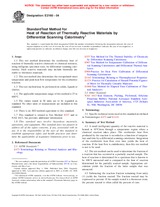We need your consent to use the individual data so that you can see information about your interests, among other things. Click "OK" to give your consent.
ASTM E2160-04
Standard Test Method for Heat of Reaction of Thermally Reactive Materials by Differential Scanning Calorimetry
STANDARD published on 1.5.2004
The information about the standard:
Designation standards: ASTM E2160-04
Note: WITHDRAWN
Publication date standards: 1.5.2004
SKU: NS-44510
The number of pages: 5
Approximate weight : 15 g (0.03 lbs)
Country: American technical standard
Category: Technical standards ASTM
Annotation of standard text ASTM E2160-04 :
Keywords:
degree of cure, differential scanning calorimetry, hazard potential, heat of reaction, thermal analysis, thermoset, ICS Number Code 71.040.40 (Chemical analysis)
Additional information
| Significance and Use | ||||||||||||||||
|
This method is useful in determining the extrapolated onset temperature, the peak heat flow temperature and the heat of reaction of a material. Any onset temperature determined by this method is not valid for use as the sole information used for determination of storage or processing conditions. This test method is useful in determining the fraction of a reaction that has been completed in a sample prior to testing. This fraction of reaction that has been completed can be a measure of the degree of cure of a thermally reactive polymer or can be a measure of decomposition of a thermally reactive material upon aging. The heat of reaction values may be used in Practice E 1231 to determine hazard potential figures-of-merit Explosion Potential and Shock Sensitivity. This test method may be used in research, process control, quality assurance, and specification acceptance. |
||||||||||||||||
| 1. Scope | ||||||||||||||||
|
1.1 This test method determines the exothermic heat of reaction of thermally reactive chemicals or chemical mixtures, using milligram specimen sizes, by differential scanning calorimetry. Such reactive materials may include thermally unstable or thermoset materials. 1.2 This test method also determines the extrapolated onset temperature and peak heat flow temperature for the exothermic reaction. 1.3 This test method may be performed on solids, liquids or slurries. 1.4 The applicable temperature range of this method is 25 to 600°C. 1.5 SI units are to be regarded as the standard. 1.6 There is no ISO method equivalent to this standard. 1.7 This standard is related to Test Method E 537 and to NAS 1613, but provides additional information. 1.8 This standard may involve hazardous materials, operations, and equipment. This standard does not purport to address all of the safety concerns, if any, associated with its use. It is the responsibility of the user of this standard to establish appropriate safety and health practices and determine the applicability of regulatory limitations prior to use. |
||||||||||||||||
| 2. Referenced Documents | ||||||||||||||||
|
We recommend:
Technical standards updating
Do you want to make sure you use only the valid technical standards?
We can offer you a solution which will provide you a monthly overview concerning the updating of standards which you use.
Would you like to know more? Look at this page.




 Cookies
Cookies
